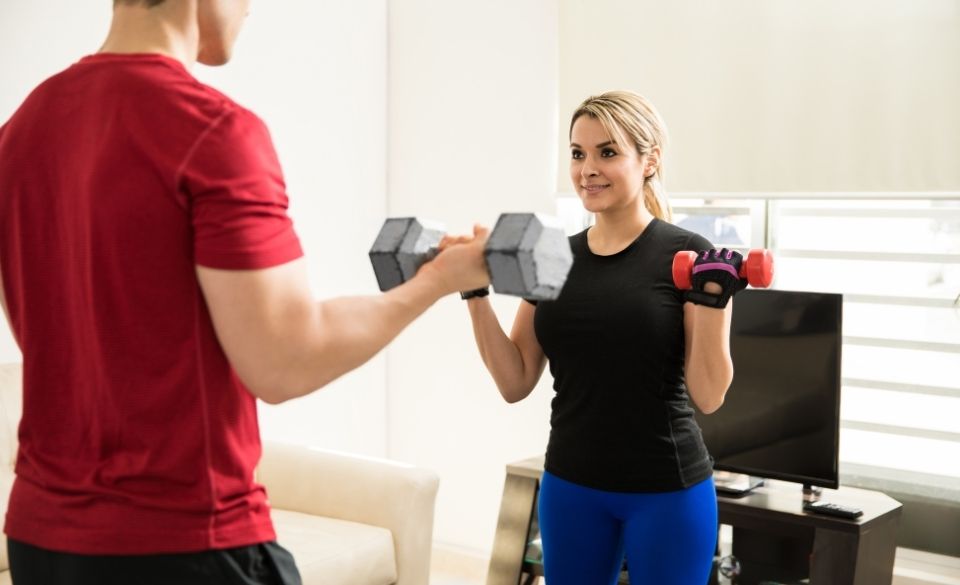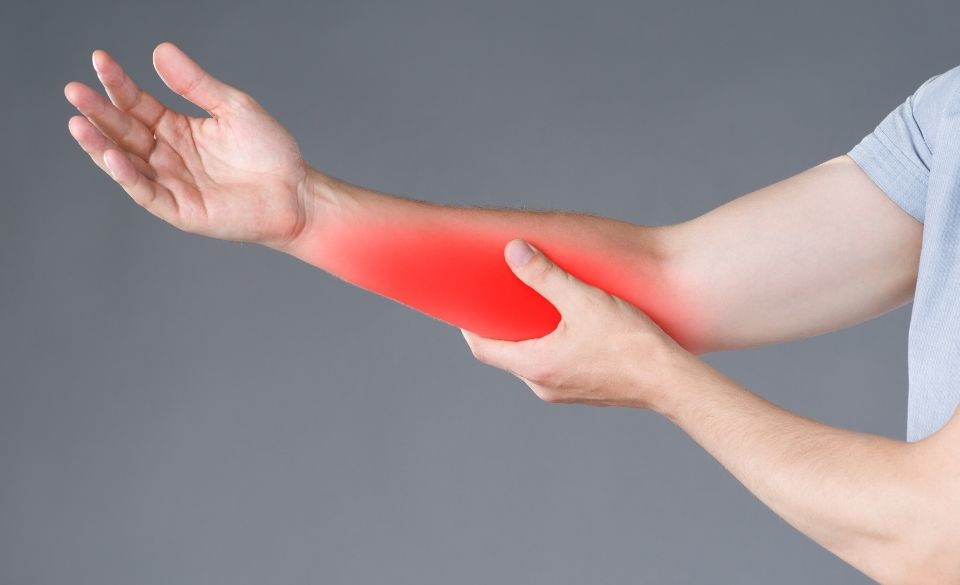
Forearm Pain When Curling – Guide To Bicep Curls 2022
Page Contents
Curling or commonly known as a bicep curl is an essential part of most strength training routines. It can be done with dumbbells, a barbell, or even resistance bands or a cable. However, since it is such a widely used exercise it often causes injury and soreness in the forearm.
In this article, we discuss why you might feel forearm pain when curling, and how to prevent it. So, keep reading to learn more.
What Is A Bicep Curl?
A bicep curl refers to an exercise using a barbell, resistance band, or dumbbells to target the bicep muscle (biceps brachii)
A bicep curl (or curling) usually starts with your arm in an extended state while holding a weight. Palms are usually facing upwards and a full repetition involves bending or curling the arm until the elbow is fully flexed.
Once the elbow is fully flexed, the arm slowly lowers the weight back to the starting position.
During this movement, the torso is positioned in an upright position. This helps prevent other muscles from supporting the weight and increases the effectiveness of the exercise.
When doing this curling exercise it is important to keep your elbows to the side of the torso. This helps the elbow to be positioned in front of the weight’s center of gravity, limiting tension around the biceps before contraction.
What Are Bicep curls Good For?
Now you may be wondering what the bicep curls are good for. They are generally used to build strength in the arm and help strengthen supporting muscles.
Since the biceps cooperate with elbow flexion, forearm supination, and stabilization of the shoulder muscles, they help you maintain a strong and healthy upper body.
The bicep muscles (biceps brachii) are used a lot in our daily life, so having a strong bicep muscle can help you lift objects, run, and much more. They also help you to have more defined arm muscles, which translate into a better physique.
How To Do A Bicep Curl – Complete Guide
Even though there are many variations of the bicep curl, the steps below will help you to perform the bicep curl for the first time.
Step 1
Start by standing tall and with a dumbbell in each hand. Rest your elbows close to the side of your body and keep your forearms extended. Make sure your knees are slightly bent and try to engage your core muscles.
Step 2
Now bring the dumbbells up to your shoulders while keeping your elbows in the same position. Once you have reached your shoulders hold for a few seconds. During these few seconds make sure you squeeze the muscle.
Step 3
Slowly move the dumbbell back to the starting position while keeping the elbow in the same position. Make sure this movement is slow and controlled. Rushing this part of the exercise will ultimately lose some of the benefits of curling.
What Is Curling?
Bicep curls are one of the most common weight training exercises and are often called curling. However, there is no difference between curling and bicep curls. It is generally just a term used by regular gym users when doing the bicep curl exercise.
Curling can involve the use of dumbbells, resistance bands, barbells, and cables. However, people that don’t have access to a gym can use a wide variety of other weights or objects.

Forearm Pain When Curling – What You Should Know
If you are noticing forearm pain when curling there may be a couple of reasons why.
Tight or tense muscles – Tight muscles or muscles that are tense are one of the most common causes of forearm pain when curling. If you start doing bicep curls with tense muscles, you may find that they get even tighter when you start curling.
However, sometimes the tightness and tension can squeeze or compress the nerves in your forearm. This can often result in a burning sensation or shooting pain up the forearm during a curl.
Not warming up properly – Like any exercise you are doing, warming up correctly can impact how the muscles move and feel. If you start a bicep curl without a correct warm-up you may find it cause pain and discomfort since the muscles aren’t warmed up.
A warm-up is vital to increasing blood flow to the muscles, which helps them to prepare for the rigors of exercise, regardless of the movement. By warming up correctly you will also reduce the chances of injury and help your body’s temperature and oxygen rise. These are all things that will help you perform better and more efficiently.
Weights that are too heavy – If you are doing bicep curls for the first time it is easy to get excited and try to push your limits. However, it is important to choose a weight that is heavy enough to reap benefits, but not heavy enough to cause pain or injury. It is always safer to start out with a lower weight than you think is necessary and slowly build up over the next few weeks. That way you will prevent muscle soreness, DOMS, and pain in the forearm when curling.
Luckily if you are experiencing forearm pain during a curl, there are some ways to prevent it. Regular massage can help reduce tightness and tension in the muscles. Alternatively, visiting a sports therapist, sports rehab therapist, physical therapist or sports physio can help release tension in the arms. Allowing you to continue strengthening the biceps without pain.
Stretching is another prevention method that can help prevent soreness of the forearm both during and after curling. By doing regular stretching you can help relieve tension in the bicep muscles and restore full mobility.
Last but not least is icing. If you are experiencing swelling or redness from doing a curl you may need to reduce the inflammation. By icing regularly you can help reduce inflammation in the forearm and speed up recovery. However, it is important if you do have inflammation back off doing bicep curls until it has been relieved.
Regardless of the method you use, it is important to keep the muscles relaxed and supple. That way you can focus on improving your bicep strength without pain.


